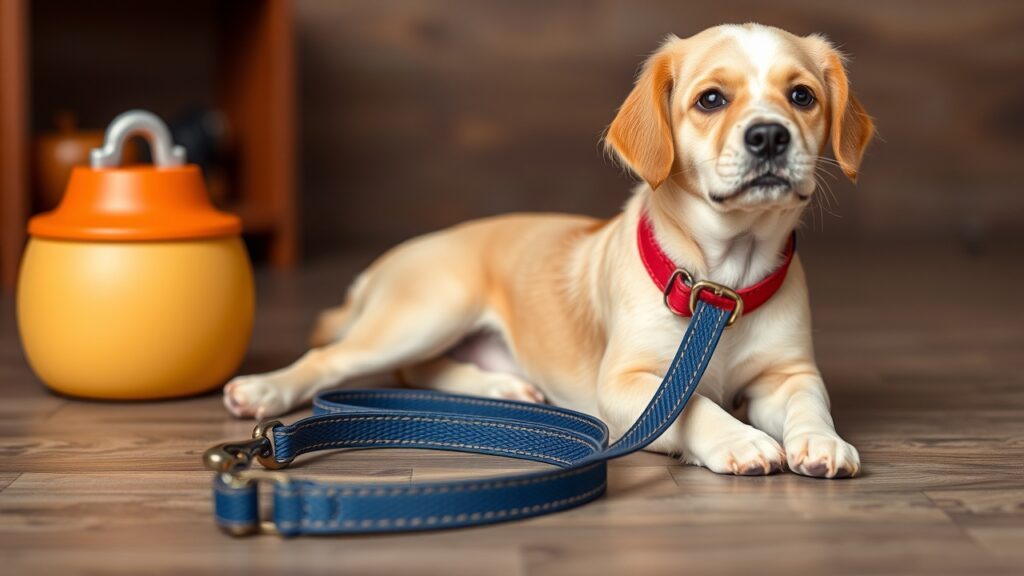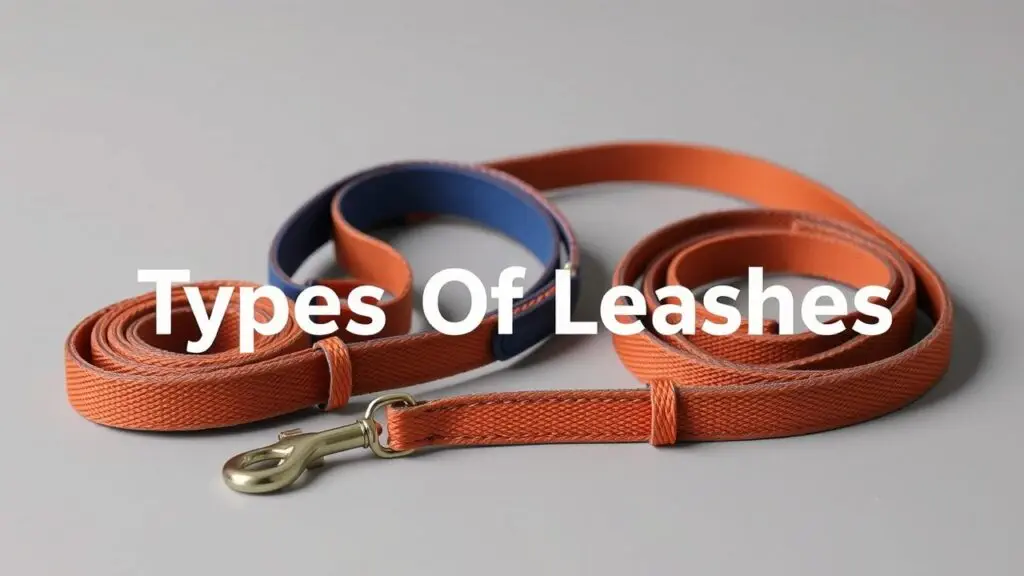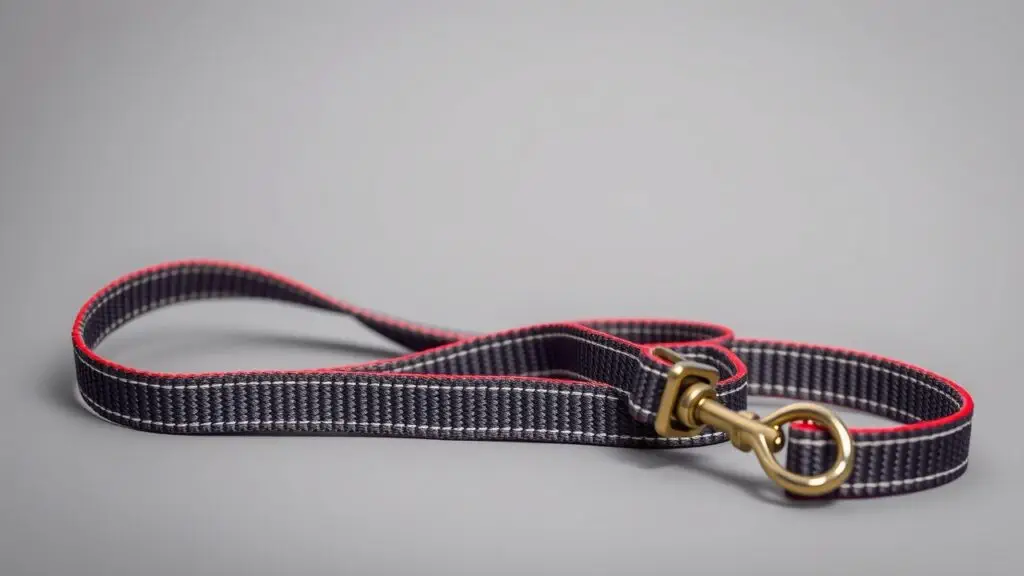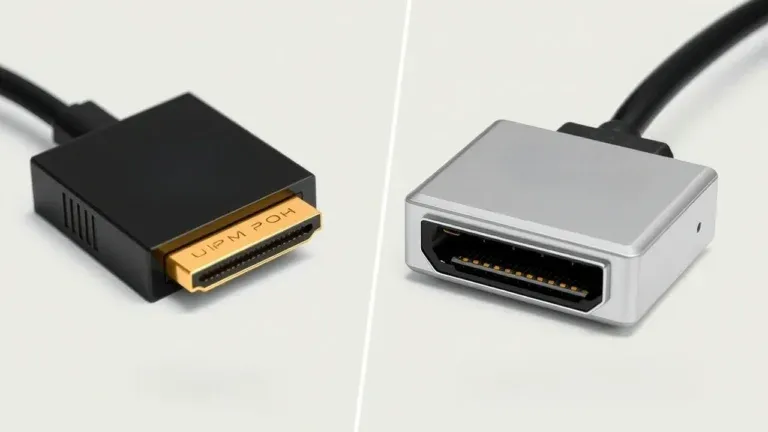This guide covers retractable, adjustable, and other types of dog leashes, comparing materials like nylon, leather, and chain to help you choose the best one for your dog’s size and walking style.
What is a dog leash?

A dog leash is an important tool for pet owners. It keeps your dog safe and helps you control them during walks and training. A leash connects the dog’s collar or harness to your hand or body. This connection is key for safety in different places and helps with good behavior.
There are several types of dog leashes, each serving different needs:
- Standard Dog Leash: Usually made from nylon or leather, this leash has a fixed length that gives you good control over your dog.
- Adjustable Dog Leash: You can change its length, which makes it flexible for different situations.
- Nylon Leash: Light and strong, nylon leashes are popular because they are affordable and come in many colors.
- Leather Leash: These are strong and comfortable. They look nice but need some care to keep them nice.
- Chain Leash: Best for strong dogs that might chew other leashes; they can be heavy and not as comfy.
- Rope Dog Leash: Made from climbing rope material, these leashes are tough and provide a good grip.
Why choosing the right leash matters?
Picking the right dog leash affects safety and training success. Different leashes fit specific needs based on your dog’s size, breed, and activities like walking multiple dogs or training sessions. Using the wrong leash can cause problems. Here are some points to think about:
- Size: Smaller dogs need lighter leashes while bigger dogs require stronger ones.
- Behavior: Dogs that pull a lot may need no-pull harnesses with suitable leads.
- Environment: Retractable leashes work well in open areas but can get tangled in busy spots.
Choosing the right leash makes walks more enjoyable. It also shows responsible pet ownership by keeping your furry friend under control at all times.
Types of Dog Leashes Explained
Standard Dog Leash
A standard dog leash is a must-have for every dog owner. It’s usually made from strong materials like nylon, leather, or rope. These leashes help you keep control and make walks comfy for both you and your dog. A nylon leash is lightweight and easy to clean, great for daily walks. A leather leash is tough and stylish but might need some care. The rope leash is very strong, making it a good choice for bigger dogs.
When picking a standard dog walking leash, think about its length and width. Most leashes are between 4 to 6 feet long. This length lets your dog move around but keeps them safe nearby. Look for leashes with padded handles; they help reduce strain on your hands during longer walks.
Retractable Dog Leash
Retractable dog leashes give you flexibility. You can change the length based on what your dog needs at that moment. These adjustable leashes can stretch up to 26 feet or more, letting your dog explore while staying under control. But watch out! There are safety risks with retractable leashes; they can tangle or cause injury if used wrongly.
Many owners like how light retractable leashes are, but it’s super important to teach your dog how to walk calmly without pulling too hard on the line.
Slip Lead/Leash Combination Collar-Leash System
The slip lead combines a collar and leash in one simple tool. It tightens slightly when pulled but loosens when relaxed. This type of lead works well in quick control situations where you need an instant response—like during training or in crowded places.
Slip leads are great training aids because they help dogs learn how to walk nicely without needing extra gear like collars or harnesses. Trainers often prefer them due to their simplicity and effectiveness with many different breeds.
Training Long Line Leash (10–50 ft)
Training long line leashes are ideal for teaching distance commands while giving dogs plenty of space to run safely in parks or open areas. They come in lengths from 10 feet to 50 feet, providing better control over your dog’s movements compared to short leashes.
Using a long line helps reinforce recall commands since it allows dogs more freedom while keeping them connected through the handle at all times—a perfect option if you’re hiking with your furry friend!
Choosing the Right Leash: A Decision Tree
Choosing a dog leash is super important for you and your dog’s comfort. With many leashes out there, knowing their features can help you make the best choice. This guide covers key points to think about when picking a dog leash.
Consider Your Dog’s Size and Strength
Think about how big and strong your dog is. Different leashes are made for small and large dogs. Here are some options:
- Leash for Small Dogs: Lightweight leashes made of nylon or fabric work great for small breeds. They offer control without weighing down your pup.
- Leash for Large Dogs: For bigger dogs, use sturdy options like leather or thick nylon. These materials are tough enough to handle strong pulls.
Picking the right type for your dog’s size makes walks safer and more enjoyable.
Assess Your Dog’s Temperament
Your dog’s behavior matters too when choosing a leash. Here are some suggestions based on temperament:
- Leash for Aggressive Dogs: If your dog shows aggression, consider a strong slip lead or a head halter leash that gives you better control.
- No-Pull Harness Leash: For dogs that tend to pull on walks, using a no-pull harness with a special leash can help keep them in check.
Understanding your dog’s reactions helps you find the right leash.
Evaluate Training Level and Experience
The training stage of your dog is another factor:
- Puppy Leash Training Tips: Puppies need shorter leashes for close supervision while learning commands.
- Dog Training Equipment: For recall training, longer leashes give your dog some freedom while keeping you in control.
Knowing where your dog is in training helps you choose effective tools.
Analyze the Walking Environment
Where you walk your dog also affects what gear you should use:
- Retractable Dog Walking Gear: In safe, open areas, retractable leashes let your dog explore more but should be used carefully.
- Leash Laws & Etiquette: Always check local leash laws before going out. Some places have rules about what type of leash is needed for safety.
Being aware of the walking area helps keep everyone safe during walks.
Prioritize Safety
Safety is always first when picking any equipment:
- Responsible Use of Retractable Leashes: Though handy, retractable leashes require careful handling to avoid accidents—especially in busy spots.
- Dog Safety Tips & Bite Prevention: Make sure collars and harnesses fit well; loose gear could cause escapes or injuries. Regularly check equipment for damage since worn-out items can be risky!
Putting safety first while choosing the right leash ensures good times every time you head out with your furry friend!
Dog Leash Safety and Maintenance
Safety Tips
Keeping your dog safe while on a leash is super important. Always watch your dog during walks. This helps to avoid accidents, especially in busy places. Make sure the leash fits well. It shouldn’t be too tight or too loose so your dog stays comfy and under control.
Check the leash regularly for any wear or damage. Look for frayed edges or broken clasps. These issues can make the leash less safe. If you use a retractable leash, be careful in crowded areas. These leashes can tangle with other dogs or people, leading to injuries.
Following these safety tips will help you be a responsible dog owner and enjoy safe walks with your furry buddy.
Maintenance and Cleaning
Taking care of your dog’s leash can make it last longer. Different materials need different cleaning methods:
- Nylon Leashes: Wash them with soap and water to get rid of dirt and smells. Let them air dry before putting them away.
- Leather Leashes: Use a damp cloth to wipe off surface dirt. To keep it flexible, apply leather conditioner from time to time.
- Chain Leashes: Clean these by wiping them with oil every now and then to stop rust from moisture.
By following these cleaning tips based on the type of material—nylon, leather, or chain—you’ll keep your durable dog leashes in great shape.
Specialized Leashes: Double-Ended, Bungee, and More

Double-Ended Leashes
Double-ended leashes are great for dog owners who need to control multiple dogs or want better management during walks. These leashes have clips at both ends. You can attach one end to your dog’s collar or harness and the other end to a different spot on the same harness. This is super helpful for training or walking two dogs at once.
Pros of Double-Ended Leashes:
- Better Control: Connecting at two points gives you more stability.
- Training Tool: Perfect for training sessions where guidance is needed without pulling.
- Multiple Dog Walking: Great for people with more than one pet since it lets you handle both easily.
Cons of Double-Ended Leashes:
- Somewhat Complicated: New dog owners might find them confusing.
- Short Length Options: They often come in shorter lengths, which may not fit all walking styles.
Bungee Leashes
Bungee leashes are unique because they have stretchy material that absorbs shock when your dog pulls away from you. This is especially good for strong pullers or active breeds.
Pros of Bungee Leashes:
- Shock Absorption: Helps reduce strain on both you and your dog when they make sudden moves.
- Comfortable Walks: Reduces the risk of injury caused by quick jerks.
- Great for Active Dogs: Perfect if your dog loves to run ahead while keeping some control.
Cons of Bungee Leashes:
- Less Control Over Pulling: Some trainers feel these can encourage pulling because they allow more freedom.
- Confusing During Training: The stretchiness might make it hard to give commands clearly during training.
Other Specialized Leashes
Besides double-ended and bungee leashes, there are other types worth knowing about:
- Martingale Leash: This leash acts like a collar and leash combo used in training. It tightens a little when pulled but doesn’t choke your dog.
- Chain Leash: Made from metal links, this type is tough but heavy. It’s best for strong chewers who could destroy fabric leashes quickly.
- Hands-Free Dog Leash: You can walk your dog while keeping your hands free. It attaches around your waist or across your body—great for jogging or hiking.
- Long Line Leash: This leash is long (often 15 feet or more), giving your dog space to roam while still being under control. It’s useful for recall training in open areas.
Choosing the right leash depends on many factors, like your dog’s size, strength, behavior, and what activities you plan to do together. Each type offers different benefits, so consider what works best for you and your furry friend!
Standard Leashes: The Everyday Walk Essential
Standard dog leashes are super popular for pet owners. They are reliable and perfect for daily walks and basic training. Most leashes are between 4 to 6 feet long and are made from common materials like nylon and leather. Their simple design makes them easy to use, allowing you to quickly attach or detach your dog.
Description
A standard leash is all about practicality. It usually measures 4–6 feet, giving your dog enough room to explore while keeping you in control. Nylon leashes are lightweight and tough, making them great for everyday walks. Leather leashes, on the other hand, offer a stylish look and can be very strong if taken care of properly.
Use Cases
These leashes work well in many situations:
- Everyday walks around the neighborhood
- Basic obedience training sessions
They help in establishing good walking habits early on, especially when introducing puppies to their surroundings.
Pros
One of the best things about standard leashes is their low cost. They are available at most pet stores and online retailers. Plus, their ease of use makes them a favorite among pet owners who prefer straightforward solutions without complicated features.
Cons
However, standard leashes might not fit every situation. For dogs that pull hard or need special training techniques, these leashes may not offer the control you need. You might want stronger options like no-pull harnesses or other strong dog leashes designed for larger breeds.
In conclusion, standard dog walking leashes provide a practical choice that balances comfort and durability. They come in both nylon and leather options, making them great whether you’re looking after small dogs or large ones.
Retractable Leashes: Freedom with Responsibility
Description
Retractable leashes help give dogs a sense of freedom while keeping them under control. These leashes have a special mechanism that lets you pull the lead in and out, usually reaching about 20 feet or more. They’re made from strong materials like nylon or leather, and many include a locking feature to keep your pet safe. With an adjustable length, pet owners can change how far their dog can roam based on the situation.
Use Cases
Retractable leashes are great for different activities with your dog, especially in parks and open spaces. They allow your dog to explore while you still have control. Here are some perfect times to use them:
- Dog Walking: Let your pup sniff around while staying close.
- Running: A retractable leash gives your dog some room to move as you jog.
- Hiking: On trails, these leashes let dogs wander but keep them safe.
Pros & Cons
Pros:
- Freedom of Movement: Dogs get more chances to explore their surroundings without being tied down.
- Convenient Design: The ability to easily pull the leash back makes managing your pet simple when needed.
Cons:
- Safety Risks: If not used correctly, quick stops can hurt both dogs and owners.
- Not for Every Environment: In crowded places, these leashes might cause tangling issues.
Slip Leashes: Quick Control and Training Aid

Description
A slip leash, or slip lead, is a handy tool that combines a collar and a leash. Its loop design makes it easy to put on your dog by sliding over their head. This feature allows for quick control when you need to manage your pet in different situations. It’s great for training and when you need fast access.
Use Cases
Slip leashes are perfect for times when you need immediate action. For example, they are often used during vet visits or training sessions. Their simple design is helpful for quick use; you don’t have to deal with traditional collars that take longer to adjust.
Pros & Cons
Slip leashes have some clear benefits. They are easy to attach and remove quickly. However, there are risks too. If not fitted right or used wrongly, they can cause choking or injury. It’s important for pet owners to know these risks while enjoying the convenience of this leash type.
Proper Usage Instructions
When using a slip lead:
- Make sure it fits comfortably around your dog’s neck without being too tight.
- Don’t pull too hard on the lead; this helps avoid choking.
- Keep an eye on your pet closely while using this collar-leash system.
Understanding both the good and bad sides of slip leads helps dog owners use them effectively. This way, safety and comfort for pets can be prioritized in training routines.
FAQs About Dog Leashes
What is the best leash for puppies?
Lightweight nylon leashes are ideal for puppies. They provide comfort and control without being too heavy.
Which leash is suitable for strong pullers?
Consider a no-pull harness leash. This combination helps manage strong pulling while keeping your dog comfortable.
What leash should I use for hiking?
A durable long line leash works well for hiking. It gives your dog space to explore while maintaining control.
Are there special leashes for aggressive dogs?
Yes, a head halter leash or a strong slip lead is recommended for aggressive dogs. These provide better control and safety.
How do I choose the right length for my dog’s leash?
The best length usually depends on your environment. Use shorter leashes in crowded areas and longer ones in open spaces.
What materials are dog leashes made from?
Common materials include nylon, leather, cotton, and chain. Each has its benefits in terms of durability and comfort.
Can I use one leash for two dogs?
Yes, a coupling leash allows you to walk two dogs together safely and effectively.
What features should I look for in a dog leash?
Look for padded handles for comfort, reflective materials for safety at night, and sturdy clips for security.
Types of Dog Leashes: Essential Points
- Back Clip Harness: Offers easy attachment points on the back.
- Front Clip Harness: Helps reduce pulling with front attachment.
- Bike Leash: Keeps dogs safe while biking; attaches securely to bikes.
- Reflective Leash: Increases visibility during night walks.
- Leash Length: Affects control; shorter lengths provide more handling ability.
- Leash Width: Wider leashes offer better grip and durability.
- Leash Clip Types: Bolt snap clips are secure; trigger snap clips are easy to operate.
- Dog Leash Accessories: Consider waste bag dispensers and reflective strips for added convenience.
Choosing the right dog leash involves understanding various types that meet specific needs based on size, behavior, and activities. Each option plays a key role in ensuring safe and enjoyable walks with your pet.
Related Topics
- Types of dog leash materials
- Types of dog harnesses
- Types of dog collars
- Types of leash clips
- Types of dog walking equipment
- Types of training leashes
- Types of leashes for different dog breeds
- Types of leashes for different dog sizes
- Types of leashes for different dog temperaments
- Types of leashes for different walking environments



Types of Dog Leashes: A Complete Guide